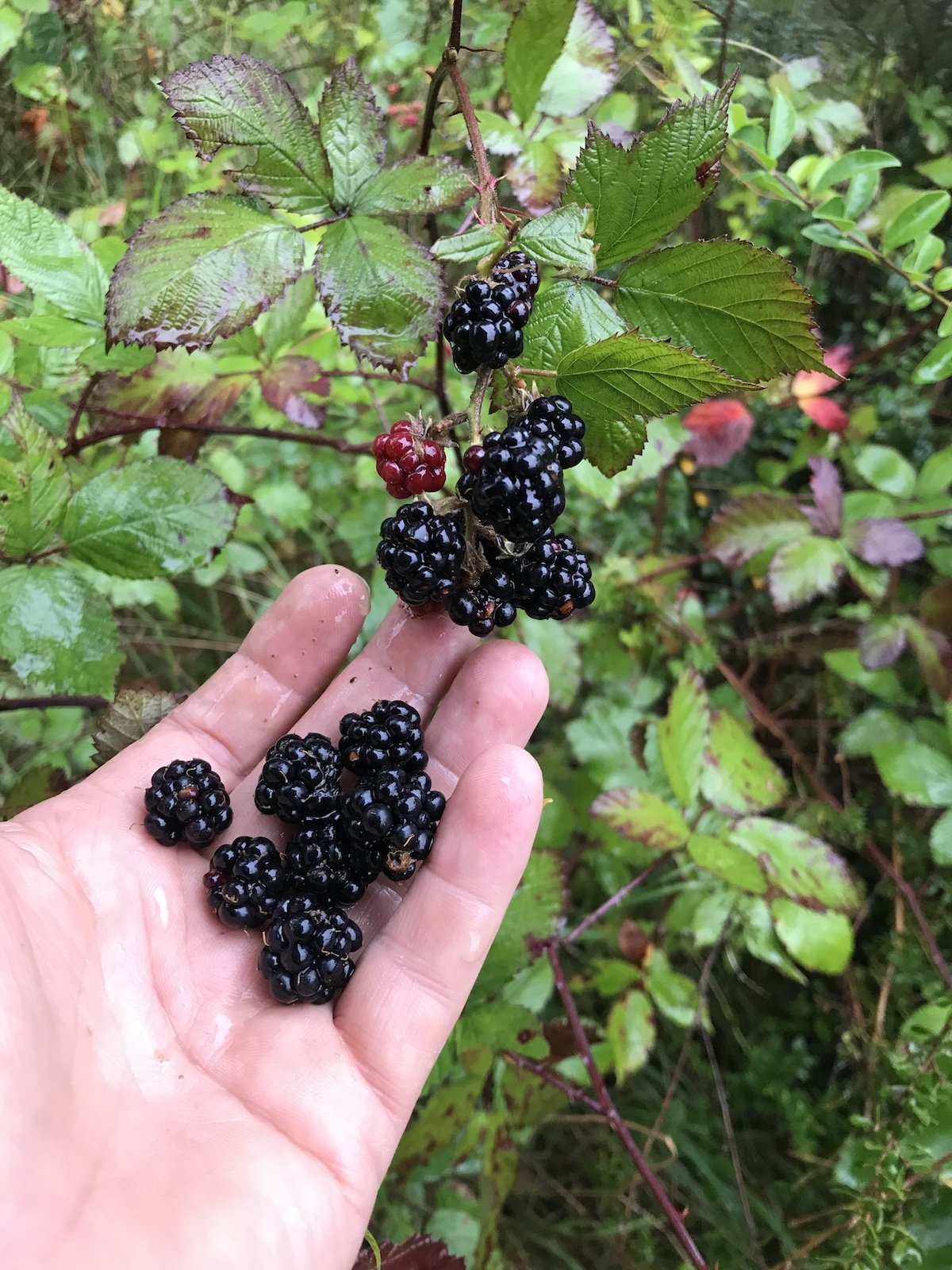Blackberries in Australia- How to identify and where to forage the seasonal abundance
Blackberry foraging is one of the most straightforward, wild-food gathering activities, and is available in a wide variety of environments. These plants are easy to recognise and relatively simple to harvest (apart from the thorns) – and when you find the right bush, they are just delicious!
The thorns can be painful and boring, clinging to your clothes, and if you’re not careful they can cause injuries, bad scratches in particular. In my opinion, the best way to harvest these fruits is by slowing down – if you’re too hasty you get caught in the branches. I am confident plenty of you readers would have had experiences foraging for these seasonal treats.
The blackberry is so common that it has been declared a Weed of National Significance for its adverse impact on agriculture, tourism and native ecologies. For that reason, blackberry bushes are often sprayed with herbicides, particularly along roadsides and in agricultural settings. Please make sure you know your local colony has not been poisoned before harvesting.
Identification
Botanical drawing by Mirra Whale
The blackberry is a semi-deciduous scrambler, meaning it loses its leaves every year. However, by the time the last of the season’s leaves are gone, the new ones are already forming, so you will never see a bush without some foliage.
It forms thick, thorny bushes up to 2 metres in height, with branches (canes) extending to about 7 metres long. There are many varieties and microspecies of blackberries in Australia, and scientists refer to them collectively as ‘Rubus fruticosus aggregate’.
Leaves and canes
Immature fruits on a blackberry bush.
The leaves are usually made of three or five egg-shaped leaflets. They can vary in size from 3–9 centimetres long and 2–5 centimetres wide, and are dark green on the upper surface and lighter underneath. The ribbed canes start off green when young and turn reddish or purple with age. Blackberry thorns are straight or curved and appear along the entire length of the canes.
Flowers and fruit
In spring and summer, white or pink flowers appear, up to 3 centimetres wide and comprising five petals. The size of the fruit varies from 1 to 3 centimetres across; initially green, it ripens through red to black. The fruits are made up of several juicy berries, each with a 1–2 millimetre seed inside.
Distribution
Blackberries are a complex species as the cross-breed and create lots of micro-species. These days botanists used an umbrella term for a groups of related species, Rubus fructicosus species aggregate, where the aggregated are:
Rubus fruticosus L. | Rubus anglocandicans A. Newton | Rubus cissburiensis W.C. Barton & Ridd. | Rubus echinatus Lindl. | Rubus erythrops Edees & A. Newton | Rubus laciniatus Willd. | Rubus leightonii Lees ex Leight. | Rubus leucostachys Schleich. ex Sm. | Rubus phaeocarpus W.C.R. Watson | Rubus polyanthemus Lindeb. | Rubus riddelsdellii Rilstone | Rubus rubritinctus W.C.R. Watson | Rubus ulmifolius Schott var. ulmifolius | Rubus ulmifolius Schott var. anoplothyrsus Sudre | Rubus vestitus Weihe
The main thing to remember here is: they all look very similar, they all are exotic and weedy and all of them are edible.
Here is the map of the species aggregated as recorded in the Australasian Virtual Herbarium>
As food
The trick to foraging for blackberries is to find a good colony. I have never found excellent bushes around the Sydney Basin – here they never mature into a sweet treat – but just venture further north, west or south and there they are, juicy glorious and blooming.
They also grow well in Victoria and Tasmania where you can get some excellent juicy, sweet, fruity harvests. There are lots of varieties and subspecies, so the flavour and fleshiness of the fruits varies a lot from plant to plant. The best bushes produce big berries for several months, from November to April. The fruits can be preserved as syrups, jams and jellies, while the young leaves are widely used in herbal tea blends, adding a fruity flavour.
You can also eat the young shoots raw. Harvest them when they emerge from the ground, then peel them and add to salads.
I love to eat the new leaves as they emerge from the canes, when they are super green and too soft to be thorny. Some bushes taste better than others and range from sour, high tannins to fruity and sweet. Find your best tasting bush and map it, it would give you a fruity treat all year round, even when the berries are not there.
Plant Based Blackberry and Banana Muffins
Ingredients:
1 very ripe banana 1 full cup of freshly foraged blackberries
1 1/2 cups plant based milk (soy, almond or coconut)
2 tbsp of melted plant butter (nuttlex is fine)
2 tsp apple cider vinegar
2 tsp vanilla extract
1/4 cup maple syrup
1 1/2 cups of coconut, rice or almond flour
1/2 cup tapioca flour
1 tsp baking soda
2 tsp baking powder
1/4 tsp salt
Plant based recipe by Marnee Fox of Forage to Feast Australia
Method:
Preheat oven to 175. Line or grease 10 muffin cups.
Into a mixing bowl, add bananas and mash until pureed.
Pour in the plant milk, butter, apple cider vinegar, vanilla and maple syrup and whisk until combined.
Then add in the flour, baking soda, baking powder and salt and whisk until everything is well combined.
Lastly, add the fresh blackberries and lightly mix them in so they keep their shape. Don't worry if they do go a bit mushy because they’ll still taste yummy and your muffins will look a bit purple.
Divide between muffin cups and put them in the oven.
Bake for 22-25 minutes or until the top of the muffin is springy to the touch and the toothpick comes out clean when inserted in the middle (a few cooked crumbs is ok).
Let them sit in the pan for no more than 2 minutes and then carefully transfer them to a wire rack to cool completely.
Share and enjoy!
Blackberry as medicine
Blackberries are very nutritious, famously being packed with high amounts of vitamin C, K and Manganese. The fruit has been appreciated for its antioxidant qualities and for the soluble fibres. Greeks and Romans used blackberry leaves, bark and roots medicinally to treat bowel problems and fever. They were also boiled in water and given as medicine for whooping cough. First Nation American Miꞌkmaq used the bark and roots for children's diarrhea. In 1771, it was documented that blackberry decoctions would cure ulcers. See here for a couple of recipes for blackberry root-bark preparations, blackberry wine and vinegar.
The scientific evidence for many of these remedies is lacking but there is considerable data on high levels of anthocyanins and other phenolic compounds, mainly flavonols and ellagitannins, which contribute to its high antioxidant capacity and other biological activities.
Blackberries in popular culture.
Whether you love it or hate it, blackberries carved a memorable place in many people’s lives and folk lore. It is common to hear older generations of foragers talking about harvesting blackberries in the paddocks for their seasonal tarts. Blackberry jam provided plenty of sugary treats to young Australians going to school. Another common reference to the bushes is as a hiding spot for rabbits, which formed an important food source for both colonist and indigenous populations up to recently. Folk stories abound and is a testament to how much we connected through the millennia with this plant. Obscure tales from the old world speak of a child who did not willingly learn to walk. The Wise Woman of the village would direct its troubled mother to make it creep through the long withes of the Blackberry-bush. Or the strange idea that if anyone eats a Blackberry after Old Michaelmas Day (October 10th), death or disaster will alight either on the eater or his kinsfolk before the year is out. The bramble or blackberry-bush is said to be the burning bush, in the midst of which Jehovah appeared to Moses. And according to some accounts, it was the bramble that supplied the thorns, which were plaited into a crown, and worn by Jesus just prior to the crucifixion.
In medieval England, bramble ( blackberry) was thought to be capable of “curing hernia or rupture when used aright, to which end the afflicted child is passed backwards and forwards through the arching bramble.”
Love it or hate it, blackberries are around. Learn your colonies as now is the time, and berries abound.
Please note that this is a restricted species and it is often poisoned. Make sure you know your local colonies and how they have been managed. If unsure call your council. Also, be careful of the thorns!
#Yayforweeds.
DISCLAIMER: This information should be used as a guide only. It is not my intention to advise anyone on medical conditions, rather I'm just presenting a new way to look at the plants growing around you.
Let me help: if you are unsure about the identity of your plants tag me in a picture or comment below, and I’ll endeavour to help.
Further readings and links
Botanica: Herbal medicine encyclopedia
Plant For A Future: Edible plants database
North American Ethnobotany Database
Australian Living Atlas: Map of blackberries in Australia
Spoonuniversity: a few fun recipes with your berries
WebMD: Healthy eating blackberries
Weeds NSW: Profile of Blackberries as a Weed of National Significance
GoodFood on Health Benefits of Eating Blackberries
Medical News Daily: Health Benefits of Blackberries
Plant Lore, Legends and Lyrics: eBook
Pubs.acs.org: Scientific publication on blackberry health benefits








